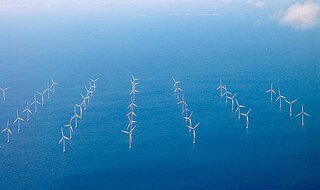
Horns Rev is a shallow sandy reef of glacial deposits in the eastern North Sea, about 15 km (9.3 mi) off the westernmost point of Denmark, Blåvands Huk. The reef contains the Horns Rev Offshore Wind Farm.

The United Kingdom is the best location for wind power in Europe and one of the best in the world. By 2023, the UK had over 11 thousand wind turbines with a total installed capacity of 28 gigawatts (GW): 14 GW onshore and 14 GW offshore, the sixth largest capacity of any country. Wind power generated about 25% of UK electricity, having surpassed coal in 2016 and nuclear in 2018. It is the largest source of renewable electricity in the UK.
The Thanet Wind Farm is an offshore wind farm 7 miles (11 km) off the coast of Thanet district in Kent, England. On commissioning it was the world's largest offshore wind farm. It has a nameplate capacity of 300 MW and it cost £780–900 million (US$1.2–1.4 billion). Thanet is one of fifteen Round 2 wind projects announced by the Crown Estate in January 2004 but the first to be developed. It was officially opened on 23 September 2010, when it overtook Horns Rev 2 as the biggest offshore wind farm in the world. It has since been overtaken by many others.

Lillgrund Wind Farm is located about 10 km off the coast of southern Sweden, just south of the Öresund Bridge, where average wind speeds are 8 to 10 metres per second. With 48 wind turbines and a capacity of 110 megawatts (MW), Lillgrund is Sweden's largest offshore wind farm. It was designed to meet the domestic electricity demand of more than 60,000 homes. The farm's turbines have a rotor diameter of 93 metres and a total height of 115 metres.

Robin Rigg Wind Farm, Scotland's first offshore wind farm, was constructed by E.ON at Robin Rigg in the Solway Firth, a sandbank midway between the Galloway and Cumbrian coasts. The windfarm first generated power for test purposes on 9 September 2009. The wind farm was completed on 20 April 2010.

The Kentish Flats Offshore Wind Farm is a wind farm located off the coast of Kent, England on a large, flat and shallow plateau just outside the main Thames shipping lanes. The wind farm is operated by Vattenfall.

Offshore wind power or offshore wind energy is the generation of electricity through wind farms in bodies of water, usually at sea. There are higher wind speeds offshore than on land, so offshore farms generate more electricity per amount of capacity installed. Offshore wind farms are also less controversial than those on land, as they have less impact on people and the landscape.

Alpha Ventus Offshore Wind Park is Germany's first offshore wind farm. It is situated in the North Sea 45 kilometres (28 mi) north of the island of Borkum.

Blyth Offshore Wind Farm was a small coastal wind farm located 0.5 miles (0.80 km) off the coast of Blyth, Northumberland, England.

The Ormonde Wind Farm is a wind farm west of Barrow-in-Furness in the Irish Sea. The wind farm covers an area of 8.7 square kilometres (3.4 sq mi). It has a total capacity of 150 MW and is expected to produce around 500 GWh of electricity per year.
The European Offshore Wind Deployment Centre (EOWDC), also known as the Aberdeen Bay Wind Farm is an offshore wind test and demonstration facility located around 3 kilometres off the east coast of Aberdeenshire, in the North Sea, Scotland. It was developed by the European Offshore Wind Deployment Centre consortium. The scheme is relatively small - it consists of 11 wind turbines with an installed capacity of 93.2 megawatts. It is located between Blackdog and Bridge of Don near Aberdeen. First power was generated in July 2018, with full commissioning following in September 2018.

The East Anglia Array is a proposed series of offshore wind farms located around 30 miles off the east coast of East Anglia, in the North Sea, England. It has begun with the currently operational East Anglia ONE, that has been developed in partnership by ScottishPower Renewables and Vattenfall. Up to six individual projects could be set up in the area with a maximum capacity of up to 7.2 GW. The first project, East Anglia ONE at 714 MW, received planning consent in June 2014 and contracts in April 2016. Offshore construction began in 2018 and the project was commissioned in July 2020. It is expected to cost £2.5 billion.

Näsudden is a peninsula on the south coast of Gotland, Sweden. The first tests for using wind power on a large scale in Sweden, were conducted there in the 1970s. The area has since been developed into a wind farm. Part of the peninsula is a nature reserve for birds and grey seals.

Horns Rev is an offshore wind farm in Danish waters in the North Sea.











